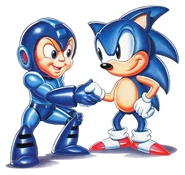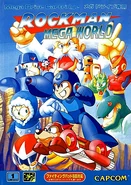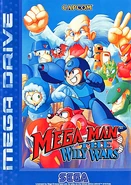Mega Man: The Wily Wars, known as Rockman Mega World (ロックマンメガワールド Rokkuman Mega Wārudo?) in Japan, is an action platformer game compilation released for the Sega Mega Drive/Genesis. It consists of the three first games in Capcom's Mega Man franchise; Mega Man, Mega Man 2 and Mega Man 3. It contains a bonus game called "Wily Tower" that is unlocked once all three games are cleared. The Wily Wars was released in cartridge format in Japan and PAL regions. The North American Genesis version was available via the Sega Channel service or online.[1][2]
Plot[]
The premise of the compilation involves the evil Dr. Wily traveling back in time in an attempt to defeat the robotic hero Mega Man in one of their first three conflicts.[3][4] Each game follows Mega Man reliving his past adventures in which Wily dispatches a set of powerful robots to take over the world which must be single-handedly stopped as before. After completing his travels through time, Mega Man must use all that he's learned and tackle the Wily Tower.
Gameplay[]
Differences[]
Mega Man[]
- While the original Mega Man's boss select screen simply showed the Robot Masters' in-game sprites as icons, the Wily Wars remake uses new mugshots to match Mega Man 2 and 3, and for Dr. Wily, his in-game sprite for an icon is replaced by the "Dr. W" logo.
- Cut Man is much tougher in the remake than he was in the original game, mostly due to the facts that his flinch is much less intense and the Mega Buster deals a third of the damage that it would normally do. Similarly, in the original game, if you get near Bomb Man, he will normally jump away, but in Wily Wars, he actually tries to get close to the player, making this harder than the original battle.
- Once an item like health/energy pick-ups is obtained in a stage (and not from enemy drops), it does not reappear if the player returns to the area where it was until all of their lives are gone. In the original, one could simply scroll off-screen and refill their energy this way (with the exception of 1-ups).
- In the original game, Mega Man can die from spikes, even if he is invincible for a brief moment after getting hit. However, in the remake, when Mega Man gets hit, he can now stand safely on spikes as long as he is flashing, which is the invincibility he's had in all subsequent games.
- Because there was no title screen music in the original version, this version uses the Mega Man 3 title music for the title screen.
Mega Man 2[]
- Quick Man is much slower in this version, though he no longer takes two damage from Mega Buster shots as he did in "Difficult Mode" or the Japanese version. Flash Man also takes one damage from the Mega Buster instead of two, like he did in "Difficult Mode."
- Some Robot Master AIs are a bit different.
- There's some music differences as well: Bubble Man's stage music's bass is much different here than it is in the NES version, and Wood Man's stage music's drum intro has four bars here instead of the six that the NES version had.
- When the player loses all of their lives, they no longer lose all their E-tanks. In the original, continuing meant forfeiting any and all E-tanks remaining in the inventory.
- The game does not have two difficulty modes.
Mega Man 3[]
- The original grey tones on Proto Man's sprites have been changed to white.
- The Wily Castle map screen music has been shortened from its original length.
- Like the first two games, some Robot Master AIs are a bit different.
- Magnet Missiles sometimes do not "home" correctly. Hard Man, the Doc Robot and Metal Man are much more difficult due to this fact.
- On the Weapon Select Menu, Rush is now blue instead of red.
- The crocodile-like traps in Hard Man's stage activate more quickly than in the original game, as do other traps.
Wily Tower[]
After beating the three games, Wily Tower is unlocked. Dr. Wily has created three new robots specifically designed to destroy Mega Man and act as guardians of the tower: Buster Rod G, a monkey boss with an extendable pole weapon, Mega Water S, an amphibian boss who attacks with harpoon shots, and Hyper Storm H, a balloon-like boss who can inhale Mega Man over to him to damage him. These robots are known as the Genesis Unit, since the game was released for the Sega Genesis, and are patterned on characters from the Chinese novel, Journey to the West.
Players are given the option to pick up to eight out of the twenty-two weapons from Mega Man 1, 2, and 3, as well as up to three out of the seven transport items from those games. Wily Tower stages feature nearly all of the enemies from the first three games.
Development[]
Artist Keiji Inafune claimed that the development of Mega Man: The Wily Wars was outsourced and rather slowgoing. He described the debugging procedure for The Wily Wars as "an absolute nightmare", even helping out in the process himself. "It was so bad," he recalled, "I found myself saying, 'I can't believe we've made it out of there alive.'"[3] Inafune based his designs of the three new Wily Tower bosses on characters from the ancient Chinese novel Journey to the West. Other than these characters, Inafune's only other illustrative contribution to the game was the depiction of Mega Man and Rush on the cover art.[3] The soundtrack of The Wily Wars consists of 16-bit versions of the original Mega Man musical scores, as well as new songs for the Wily Tower portion of the game. The composer for the Wily Wars has not been officially credited by Capcom. According to the game's sound effects creator Kouji Murata, Kinuyo Yamashita was responsible for the music composition and arrangement.[5]
Following the success of Street Fighter II′: Special Champion Edition on the Mega Drive/Genesis, rumors began circulating in the United States early 1994 that a Mega Man title was in the works for Sega's 16-bit system, the Sega Genesis.[6] The Wily Wars was displayed by Sega of America at the Sega Summit sales meeting in May of that same year.[7] The Wily Wars was first released in Japan on October 21, 1994.[3] It was the first Mega Man game to be released on a non-Nintendo console.[8] The United States magazine Game Players reported in its October issue that the North American release The Wily Wars was put on hold indefinitely due to graphical problems.[9] The April 1996 issue of GamePro reported that it had been cancelled.[10] However, the game was ultimately released in a non-cartridge format on the Sega Channel, a paid subscription service for Genesis games.[1]
Reception and legacy[]
Critical reception for Mega Man: The Wily Wars has been favorable. Christian Nutt and Justin Speer of GameSpot stated that the game is "a must for any serious Mega Man fan".[1] Sega-16 contributor Robert Menes summarized, "Although there's a few flaws that keep this from being an absolute must have, it's still Mega Man, and Mega Man games are among some of the best and brightest platformer series."[11] Jeremy Parrish of 1UP.com labeled Mega Man: The Wily Wars as "Not Worth It!" because certain design issues prevent it from aging as well as the NES versions of the games.[12] Mega Man: The Wily Wars has consistently ranked high among the editors of Nintendo Power as a game they would like to see on the Wii Virtual Console service.[13][14][15]
Elements of the game were adapted into the Archie Comics Mega Man series, with issue 20 notably including an opening that seemed to be leading into the game with the inclusion of the Genesis Unit and Mega Man Killers while issue 55 involves Dr. Light having a vision of the game's conflict.
Trivia[]
- When the collection was announced, a promotional piece of artwork (to commemorate Capcom becoming one of Sega's third-party developers for the Genesis) was made by the late freelance illustrator Greg Martin. The artwork feature Mega Man shaking hands with fellow iconic video game character Sonic the Hedgehog, the mascot of Sega. The two characters would eventually be featured in several official crossovers years later, including the comic book storyline Worlds Collide by Archie Comics and Nintendo's Super Smash Bros. series of fighting games.
- The version of Mega Man 3 featured in this collection has some game-breaking glitches, though a player is not likely to run into them accidentally. For example, lots of blue Proto Men will appear in Gamma's stage after killing him.
- The "All Stage Clear" theme from Mega Man 3 isn't featured in the Sound Test option.
Gallery[]
Box art[]
References[]
- ↑ 1.0 1.1 1.2 http://www.gamespot.com/features/6076983/p-27.html
- ↑ http://retro.ign.com/articles/880/880968p2.html
- ↑ 3.0 3.1 3.2 3.3 cite book|isbn=978-1-897376-79-9 |date=January 6, 2010 |title=Mega Man: Official Complete Works|publisher=Udon Entertainment | page=77
- ↑ cite book |editor=Capcom |title=Mega Man: The Wily Wars Instruction Booklet |date=October 1994 |publisher=Capcom Entertainment, Inc. | quote=I should have melted that meddling robot years ago. But now, with the help of my new Wily machine, I'm going to fix that. I'll just take a quick blast to the past, and I'll make sure that Mega Man will never have survived any of our first three encounters! With Mega Man destroyed in the past, there will be nothing to stop me here in the future. The world will finally be mine!!!
- ↑ https://web.archive.org/web/20110902195232/http://www.100v.jp/~yagiyama/works/index.html
- ↑ cite magazine |magazine=Mega | publisher=Future Publishing | date=January 1994 | title=News | issue=16 | page=8 | issn=0966-6206
- ↑ http://www.accessmylibrary.com/article-1G1-15414162/big-retailers-see-sega.html
- ↑ cite journal| author=Overton, Wil | title=Viva Le Mega Man | journal=Super Play| issue=30 | publisher=Future Publishing | date=April 1995 | pages=30–1 | issn=0966-6192
- ↑ cite journal | title=News: Chatter | journal=Game Players | volume=7 | issue=10 | page=16 | publisher=Imagine Media| date=October 1994 | issn=1091-1685
- ↑ cite magazine|last= |first= |title=The State of the 16-Bit World: Cancelled Games |magazine=GamePro |issue=91 |publisher=IDG|date=April 1996|page=44
- ↑ http://www.sega-16.com/2006/05/mega-man-the-wily-wars/
- ↑ https://archive.is/20120721185541/http://www.1up.com/do/feature?pager.offset=0&cId=3159344
- ↑ cite magazine |magazine=Nintendo Power | publisher=Future US | title=Most Wanted | issue=229 | date=June 2008 | issn=1041-9551
- ↑ cite magazine |magazine=Nintendo Power | publisher=Future US | title=Most Wanted | issue=235 | date=December 2008 | issn=1041-9551
- ↑ cite magazine |magazine=Nintendo Power | publisher=Future US | title=Most Wanted | issue=245 | date=September 2009 | issn=1041-9551









